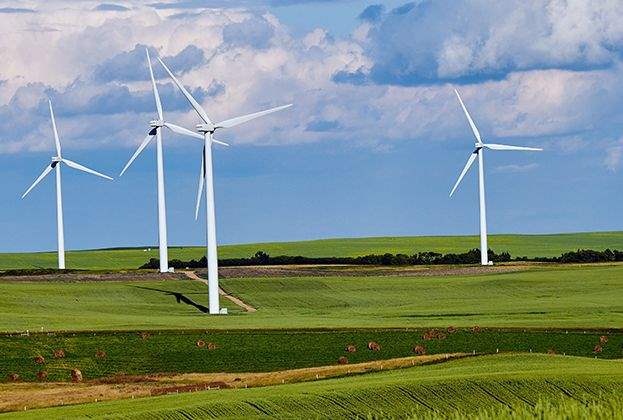The Government’s Clean Growth Strategy targets energy-saving measures for both old and new buildings, which will have an impact on future greenhouse emissions
Britain’s homes are responsible for 15% of the UK’s greenhouse gas emissions. To reduce this figure, the Government’s Clean Growth Strategy targets both energy saving measures that new buildings should employ as well as retro-fitting the existing housing stock.
It makes increasing sense for a low carbon economy to use electricity, as heat pumps are three times more efficient than gas boilers
Savills Energy
While all building regulations include some level of energy efficiencies, the Greater London Authority stands out as the best-practice example that has taken these measures further and published a London Plan that sets out exactly how it will create a zero-carbon residential sector by 2031.
“Every proposal that we submit for a residential development in London has to show what the baseline energy use of the building would have been in 2013 and then how we are reducing that by 35%,” explains Harry Renton-Rose of Savills Planning.
“The London Plan advises on an energy hierarchy of: be lean – use less energy; be clean – as in supply energy efficiently; and be green – use renewable energy. There’s now a fourth step too, of be seen, which involves monitoring the energy use so you can show exactly the difference you’re making,” says Harry.
He has recently been working on a residential masterplan of 4,000 units in West Ham. Among its zero carbon credentials, the homes will all be heated from one central energy centre running a gas-powered combined heat and power system that will transport the heat to the homes through a district heat network.
“It is far more efficient to have one large boiler that is on all the time than smaller ones being switched on and off,” explains Thomas McMillan of Savills Energy.
However, despite the efficiency, he doesn’t think planning around gas is the right way to be heading in 2019. “Natural gas is still a fossil fuel and really we’ve gone past the time when it’s beneficial to be planning around it, but policy hasn’t caught up yet,” he says.
His preferred solution is a heat pump – an electrically powered device that operates a little like a fridge in reverse. “As the national grid becomes decarbonised, it makes increasing sense for a low carbon economy to use electricity, as heat pumps are three times more efficient than gas boilers,” he says.
Although popular throughout northern Europe, the United States and Canada, heat pumps are relatively uncommon here. This is partially due to their higher upfront costs and the relative low price of gas compared to electricity.
“The Renewable Heat Incentive does offset this cost imbalance, and has been extended until 2021,” says Thomas, pointing to the Government initiative to create take-up of more renewable sources.
Heat pumps can be ground source, water source or air source depending on the location of the development. “Each one is positioned differently, so it’s essential that the right energy solution is planned right from the start of a building project,” explains Thomas. “Sustainability should not be a bolt-on item.”
.jpg)
Not all modular housing is passive house, but the cost differences are so marginal that developers ought to future-proof buildings by going down the passive route now
Savills Energy
At the moment, renewable technologies don’t add any premium to a property (“although this might change if Green Mortgages gain a greater share of the market,” says Thomas, see What Are Green Mortgages? below), which means there’s little incentive for developers to go beyond the basic requirements of building regulations when putting sustainable solutions into properties. “However, it could be viewed as an additional investment to the property itself and be done in such a way that the sustainable solutions have their own commercial value,” suggests Thomas.
“For example, a developer could fit enough solar panels on a project to run a heat pump and a car charge point, and tie all the assets together into an energy service company that retains ownership of the technologies and locks the customer into a rental agreement for 20 to 25 years. It’s not a new business model, but it could be used to justify the capital investment.”
In the wake of the Grenfell Inquiry, there are likely to be changes made to building regulations and many commentators think this will be an opportunity to use policy to reduce the emissions of new buildings. As well as looking at the heat and power sources, developers could also be expected to look at the materials and style of buildings too, such as passive houses.
These buildings are designed and constructed to require hardly any energy to heat or cool them. “The costs of factory-built modular passive housing are coming down,” says Thomas. In some parts of the UK – for example around Oxford where labour costs are at their highest – their simple construction technique makes them comparable in costs to traditional building styles. “Not all modular housing is passive house, but the cost differences are so marginal that developers ought to future-proof buildings by going down the passive route now,” advises Thomas.
With a need for 300,000 new buildings a year, building in energy efficiency will clearly have an impact on future greenhouse emissions. However, a far greater impact comes from the existing housing stock that makes up the vast majority of homes – and will still account for 80% even in 2050.
The Government has launched several measures to help encourage the retro-fitting of energy efficiency measures. For low-income homeowners, there is the Energy Company Obligation. This is a fund of £3.6 billion that is administered through energy suppliers installing measures such as wall and loft insulation to reduce heat loss from customers’ homes. For rental properties, landlords now have to make sure that any property having a new tenancy agreement must have an Energy Performance Certificate (EPC) rating of E or above.
House by house, changes are happening and although emissions from the residential sector are already 25% lower than they were at the beginning of this century, with 27 million households in the UK, it’s slow work, and there is still plenty to be done.
WHAT ARE GREEN MORTGAGES?
.jpg)
Green mortgages are a concept devised to encourage and reward homeowners for buying and investing in energy efficient homes. This could be through offering lower interest rates or higher levels of borrowing, the rationale being that if customers have lower bills, they are less likely to default on a mortgage payment. In its 2017 Clean Growth Strategy, the Government said it would be “working with mortgage lenders to develop green mortgage products”. At present, there is just one “green mortgage” available in the UK, offered by Barclays for new-build properties that meet certain criteria.
LONDON LEADING THE WAY…
Since 2016, all major residential developments in London have to show that they will be “zero carbon” – as in produce no carbon dioxide emissions over their lifetime. Part of this has to be through taking low-carbon measures, but if these don’t amount to zero emissions, developments can off-set the rest of their carbon with a cash payment – effectively a carbon tax – to the relevant borough, which the borough has to ring-fence for carbon dioxide savings elsewhere.
London’s planning guidance gives a guideline figure of £60 per tonne of carbon dioxide that needs to be paid for the 30-year lifetime of the building. However, the figure is set by the borough and varies from £104 per tonne in Lewisham to £7,560 in Westminster.
To reduce these costs, many developers are negotiating alternative off-setting solutions. In Islington, for example, one developer is providing waste heat from an electricity substation to a neighbouring school through a shared heat network. While in Camden they have agreed to install energy efficiency improvements in existing housing in lieu of the payment.
Developers looking to keep the carbon tax to a minimum need to design in energy saving measures from the very beginning. “Insulation is always the first and most cost-effective measure towards zero carbon,” says Thomas McMillan of Savills Energy. “However the reduction in costs of renewable energy over the last five years mean energy systems should be at the centre of zero-carbon thinking.”
.jpg)





.jpg)